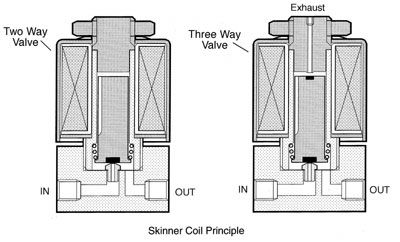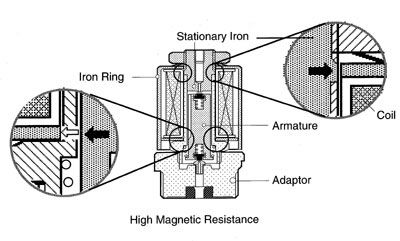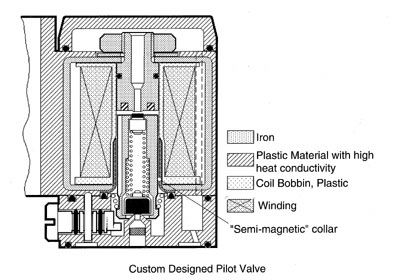| Solenoid valves are used widely throughout the pneumatics industry, as an effective and reliable method of controlling actuators and similar pneumatically operated devices. |
|
| Solenoid valves use electro-magnets to operate valve spools either directly or, more commonly, indirectly, by means of a pilot valve. |
|
| Direct operation can only be achieved in valves incorporating almost frictionless, short stroke, steel spools without seals; typically these include directional control valves, which are widely used in America. Although these devices offer relatively fast response times and can be switched at any air pressure, they are relatively large, expensive to manufacture and require additional electronic control equipment before they can function. |
|
|
In Europe, poppet and elastomer sealed spool valves are far more common. These cannot, however, be operated directly, due to their longer stroke and higher levels of internal friction. Instead a small solenoid pilot valve is used to control the flow of air to a pneumatically driven spool.
|
|
|
|
|
Early solenoid pilot valves were based on similar design to that used in directly operated valves. This was developed by an American called Skinner and was first used in the 1930s.
|
|
 |
| The Skinner design incorporates a spring loaded armature, enclosed in a tube of non-magnetic material and held against the air inlet port by the force of the spring, with the port being effectively sealed by a rubber pad inserted into the bottom of the armature. Energising the solenoid lifts the armature against the spring, allowing the supply air through to an outlet port. |
| Although the Skinner system is relatively simple and is still widely used in solenoid valves, it suffers from a number of inherent problems. Foremost among these is the disruption in the magnetic field, produced by air gaps within the solenoid core, around the iron circuit and the non-magnetic tube. These cause excess heat and noise to be generated as the armature moves, reducing efficiency and increasing the levels of power that need to be generated to operate the solenoid. |
|
|
|
The air gap between the armature and the coil also allows the armature to be drawn radially against the inner wall of the tube, again serving to increase friction and the build up of heat and further affecting the operating life of the system. In addition, the armature seals can rapidly degrade through continuous impact with the metal seat around the inlet port.
|
|
 |
| At best, traditional solenoid pilot valves based on the Skinner principle will have an operating life of between twenty and thirty million cycles. Although this may be sufficient in some applications, it can be a problem in modern automation or pick and place systems, where high switching speeds and often limited areas for installation place the various solenoid components under severe stress. In addition, the high power requirement of these devices - often in excess of 2W - often makes them unsuitable for use in systems where direct connection to PLCs or other digital controllers is required. |
|
|
|
|
|
SMC pneumatics was one of the first pneumatics manufacturers to address the problems associated with traditional solenoid pilot valves, in an effort to increase reliability, operating life and response times, while decreasing the level of power required.
|
|
|
The main source of these problems was the high levels of internal friction and the existence of air gaps at critical points in the solenoid assembly. The first step was therefore to eliminate the non-magnetic tube around the armature and to construct the iron circuit around the coil as a single closed ring. This reduces the number of components and, more importantly, removes the primary cause for the disruption of the magnetic field.
|
|
|
The tube has been replaced by a semi-magnetic collar with a low friction coating, mounted between the armature and the iron core. This serves both to guide the armature accurately, preventing radial movement, and effectively closes the final gap in the magnetic circuit, smoothing the field lines, so that frictional losses, heat and noise are reduced to a minimum.
|
|
| In addition, in the latest solenoid pilot valves the armature and seal have been separated into two discrete components, connected by a spring loaded push rod. Energising the coil causes the armature to move away from the valve seat, towards the fixed solenoid core, pulling back the push rod and allowing the valve to open. When the armature subsequently returns to its de-energised or closed position the spring compresses, acting as a cushion over the final few millimetres of travel to prevent the seal from being damaged by what would normally be a relatively heavy impact with the valve inlet port. |
| To minimise wear still further the air gap between the armature and core has been dramatically reduced, closing to a minimum of 15 microns when the armature is energised. This is sufficient to prevent the two components from making contact, thereby eliminating the problems caused in conventional solenoid valves by continuous collision damage, without impairing overall performance. |
|
 |
|
|
Maintaining a minimum air gap also helps to break the magnetic attraction between the core and armature as the latter is de-energised, helping to reduce response times to around 7msec for a valve with a double acting solenoid.
|
|
|
By reducing frictional losses and significantly improving the efficiency with which the latest generation of solenoid valves operate, it has been possible to increase service life to well over one hundred million cycles, while minimising noise and heat levels and improving response times and rates of flow. The power requirement is also far lower, typically under 1.0W, enabling the valve to be driven directly from a PLC or similar device.
|
|
|
Further improvements on this design include a vertical mounting for the pilot valve, on the side of the main valve, enabling overall dimensions to be halved, and the use of standard electrical connectors, located on the valve manifold; individual valves can then be pre-wired for connection directly to the manifold, which can be extended as required.
|
|
|
|
|
Solenoid valves are available for use with either DC or AC power sources. In simple terms, AC driven solenoid valves are comparatively large devices, consuming higher levels of power to produce a relatively slow action, while DC operated valves use small, solid state components to produce fast actions from compact devices; DC is commonly used with most modern compact solenoid pilot valves.
|
|
|
A detailed explanation of electromagnetic theory and the operating principles of DC and AC solenoids forms part of SMC’s training course on electro-pneumatics (contact the Training Department for more information). There are, however, a number of general points which should be considered.
|
|
|
Over Excitation of DC Solenoids
|
|
|
The reaction time of a DC solenoid can be shortened by applying a higher than the nominal voltage for a few milliseconds. This gives a similar effect to the inrush of an AC solenoid. When the armature reaches the end of its stroke, the voltage can be lowered to less than half nominal. This shortens the switch-off time and reduces heat.
|
|
|
Alternating and Direct Current
|
|
| Inrush/Holding Power |
| For AC solenoids there are two other factors to consider: |
| |
1. Inductance changes with the position of the armature. |
| |
2. The current and with it the magnetic force, drops to zero twice during each period. |
|
|
The inductance changes drastically with the position of the iron armature. Initially with the air gap at maximum, the force and the inductance are very low. This means that a large current is flowing into the coil to charge it.
|
|
|
This very high initial current causes an AC coil to react violently when compared with a DC coil. When the armature closes the air gap (= the iron circuit), the inductance and the total resistance increases and the current reduces. This is reflected by the catalogue specifications for AC solenoids, inrush and holding.
|
|
|
The difference between DC power and AC inrush and holding power is considerable, as shown by the table below.
|
|
| Power |
Inrush Power VA |
Holding Power VA |
DC Power W |
| AC Frequency |
|
|
| Solenoid A |
|
|
1.8 |
| Solenoid B |
|
|
1.8 |
|
|
In the case of DC (W=Watt), the current and voltage remain constant. In the case of AC (VA=Volt Amperes), both voltage and current change constantly. The difference in the figures between 50Hz and 60Hz is due to the coil resistance.
|
|
|
The solenoid coil is “sized” for the holding current, if the armature sticks, the reduction of current does not take place and the coil heats up until its insulation melts. More and more windings are then short circuited and the current rises enormously by a snow ball effect which results in “a burned out coil.”
|
|
|
|
|
Each time the alternative current goes through zero, the spring starts to return the armature. It will, in effect, only just get free from the fixed force, and then is attracted again when the current increases, with the opposite polarity.
|
|
|
This creates a sound called “hum”. Not only is this irritating, but the constant banging of the armature against the fixed force (a hundred times a second) causes deterioration in a short time.
|
|
|
To remedy this, a second magnetic feed is created, as close to 90° as possible, to bridge the gaps. This second field is called the Shading Ring.
|
|
|
|
|
A crucial factor for the efficient operation of any solenoid valve is the rapid and consistent return of the spring loaded armature to the rest position as the coil is de-energised.
|
|
|
The pressure of the return spring must be sufficient to overcome any residual magnetic attraction holding the armature in the energised position. In devices where a relatively weak spring force is used, to reduce the energy of the coil, the magnetic field has to drop to a low level before the armature is released; over time, however, the spring will inevitably weaken while the residual magnetic attraction will increase, causing the armature to stick.
|
|
|
The correct choice of spring characteristics by the solenoid manufacturer is therefore crucial to ensure that the opposing force on the armature is as low as possible, while maintaining sufficient pressure to close the valve seat afterde-energisation.
|
|
|
(Please note: for information on valve technology please refer to 'Pneumatic Valve Technology' chapter of the SMC Pneu Book)
|
|




